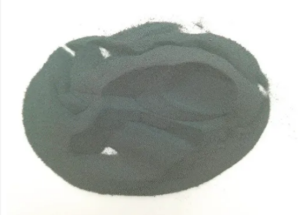
Innovative medical care: 3D printing Ti6AI4V titanium alloy for surgical implantation, leading a new chapter in metal powder printing
Performance characteristics: For the production of lightweight components for applications in motorsport and the aviation and aerospace industry. Application fields: Integrated cooling structures, bionic components and bone foam components that simulate biological structures, such as mandibular implants, joint connectors, etc. 3D metal printing uses selective laser melting technology (SLM) and selective laser sintering technology (SLS).
3D printing metal powder materials include cobalt-chromium alloy, stainless steel, industrial steel, bronze alloy, titanium alloy and nickel-aluminum alloy. However, along with excellent plasticity, 3D printing steel powder have to additionally satisfy the needs of fine bit size, narrow particle size distribution, high sphericity, good fluidness and high mass density.
Because of various applications and subsequent molding process requirements, the preparation techniques of steel powders are likewise various. The preparation procedure mostly includes physical and chemical techniques and mechanical approaches. Preparation procedures such as electrolysis, reduction, and atomization are extensively made use of in the powder metallurgy industry. Nonetheless, it ought to be kept in mind that electrolysis and reduction approaches have particular limitations and are unsuitable for alloy powder prep work. Currently, metal powders for additive production are mainly focused in materials such as titanium alloys, high-temperature alloys, cobalt-chromium alloys, high-strength steels, and mold and mildew steels. In order to meet the needs of additive production equipment and procedures, steel powder need to have attributes such as reduced oxygen and nitrogen web content, excellent sphericity, narrow fragment size distribution variety, and high mass thickness. The plasma revolving electrode method (PREP), plasma atomization technique (), gas atomization method (GA) and plasma spheroidization approach (PS) are the primary prep work methods of metal powder for additive production at present. All four procedures can be prepared Spherical or almost spherical metal powder.
1. Plasma rotating electrode method (PREP)
The Plasma Rotating Electrode-comminuting Process (PREP) is a spherical powder preparation process developed in Russia. The principle is as shown in the figure. The metal or alloy is processed into a bar and the plasma is used to heat the rod end. At the same time, the bar rotates at high speed, leaning on centrifugal drive to refine the molten droplets, solidify in an inert gas environment and react under the action of surface tension. Spheroidize to form powder; classify powders with different particle sizes through sieving. And obtain powder products after electrostatic de-inclusion (only for high-temperature alloys).
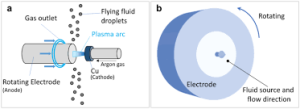
(source from Internet)
The PREP method is suitable for preparing alloy powders such as titanium and high-temperature alloys. The metal powder prepared by this method has high sphericity and good fluidity, but the powder particle size is coarse. The yield of fine particle size (0-45 μm) powder used in the SLM process is low, and the cost of fine powder is high. Since the thickness of the powder, that is, the size of the droplets, mainly depends on increasing the bar’s rotation speed or the bar’s diameter, an increase in rotation speed will inevitably put forward higher requirements for equipment sealing, vibration, etc.
At this stage, PREP’s advanced equipment and core technologies are still in the hands of Russia. Domestic units mainly rely on direct introduction or absorption, digestion and improvement after introduction to master some technologies. The General Institute of Steel Research and Beijing Aeronautical Materials Research Institute The institute and the Northwest Nonferrous Metal Research Institute introduced Russian PREP equipment in the early stage, but the current level of equipment and technology is far behind the international advanced level. Domestic universities such as Xi’an Jiaotong University and Central South University have carried out basic research on PREP process technology. The General Iron and Steel Research Institute and the Zhengzhou Machinery Research Institute jointly developed the first large-scale PREP equipment in China for the development of alloy powder materials, but the yield of titanium alloy fine powder still needs to be better. In recent years, Xi’an Ouzhong Company has introduced two sets of PREP equipment from Russia. AVIC Matt and Hunan Dingli have also independently developed complete sets of PREP equipment. The yield of titanium alloy fine powder (≤45μm) is less than 20%. Overall, there is still a gap between my country’s early introduction of PREP equipment and its current self-developed PREP equipment compared with Russia’s in overall machine performance.
Advantages: clean surface, high sphericity, few associated particles, no hollow/satellite powder, good fluidity, high purity, low oxygen content, narrow particle size distribution. Disadvantages: The powder particle size is coarse, the yield of fine-grained powder is low, and the cost of fine powder is high.
2. Plasma atomization method (PA)
Plasma atomization PA (Plasma Atomization) is a unique metal powder preparation technology of the Canadian AP&C Company.A plasma lantern installed symmetrically at the top of the smelting chamber is made use of to develop a high-temperature plasma emphasis. The temperature can also be as high as 10,000 K. An unique feeding device feeds the metal wire right into the plasma focus. Atomized into ultra-fine droplets or aerosols, during the flight deposition process in the atomization tower, it undergoes heat exchange with the cooling argon gas passed into the atomization tower to cool and solidify into ultra-fine powder.
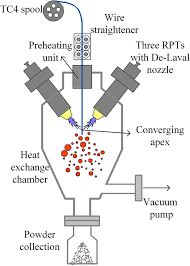
(source from Internet)
The metal powder produced by the PA method is nearly regular spherical, and the overall particle size of the powder is relatively fine. AP&C cooperates with Swedish company Arcam to expand and improve production capacity in response to the rapid development of the current additive manufacturing market. Because of the high temperature of the plasma torch, the PA method can prepare all existing high-melting point metal alloy powders. However, because this technology uses wire atomization to make powder, it limits the preparation of more difficult-to-deform alloy material powders, such as titanium and aluminum metal. Intermediate compounds, etc. At the same time, the pre-preparation of raw material wire increases the cost of powder making. In order to ensure quality control such as powder particle size, production efficiency needs to be improved. Advantages: The yield of powders below 45 μm is extremely high, and there is almost no gas entrainment in hollow spheres, which is better than the gas atomization method. The TC4 alloy used in Arcam’s electron beam forming is all prepared by this method. Disadvantages: Slightly poor sphericity, satellite powder, and higher wire cost.
3. Aerosolization method (GA)
Currently, generally used modern technologies for gas atomization prep work of metal powder materials for additive manufacturing consist of crucible vacuum induction melting atomization VIGA (Vacuum Induction-melting Gas Atomization) and crucible-less electrode induction melting gas atomization EIGA (Electrode Induction-melting inert Gas Atomization).
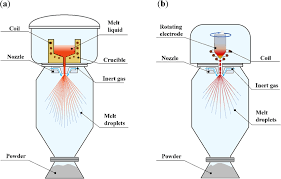
(source from Internet)
Among them, the VIGA method uses a crucible to smelt alloy materials. The alloy liquid flows through the bottom conduit of the tundish to the atomization nozzle, where it is crushed by the impact of supersonic gas and atomized into micron-scale fine droplets. The droplets spheroidize and solidify into powder. This method is mainly suitable for producing and preparing powders such as iron-based alloys, nickel-based alloys, cobalt-based alloys, aluminum-based alloys, and copper-based alloys.
The EIGA method combines gas atomization technology with electrode induction melting technology, abandons components such as crucibles that are in contact with the metal melt and lowers the slowly rotating pre-alloyed rod metal electrode into a ring-shaped induction coil for electrode melting. The electrode drops Falling into the gas atomization nozzle system and using inert gas for atomization can effectively reduce the introduction of impurities during the smelting process and achieve safe and clean smelting of active metals. It is mainly used in active metals and their alloys, intermetallic compounds, refractory metals, etc. Preparation of powder materials, such as titanium and titanium alloys and titanium-aluminum intermetallic compounds.
In recent years, powder manufacturers and milling equipment manufacturers have developed technologies such as ultrasonic atomization, close-coupled gas atomization, laminar flow atomization and hot gas atomization through the improvement of gas atomization powdering technology and have targeted According to the characteristics of additive manufacturing technology, relevant technologies have been improved, and powders that meet the requirements of additive manufacturing processes such as laser selective melting SLM and laser coaxial powder feeding can be prepared. Advantages: high yield of fine powder, 45 μm or less can be used for laser selective melting, and the cost is low.
Disadvantages: Slightly poor sphericity, lots of satellite powder, high hollow powder rate of 45-406μm powder, air entrainment, not suitable for powder metallurgy fields such as electron beam selective melting molding and direct hot isostatic pressing molding.
4. Plasma spheroidization method (PS)
Radiofrequency plasma has the characteristics of high power thickness, high home heating intensity, and huge plasma arc volume. Considering that there is no electrode, the product will certainly not be infected by electrode evaporation. The principle of radio frequency plasma powder spheroidization technology is that under the activity of high-frequency power supply, inert gas (such as argon) is ionized to develop a steady high-temperature inert gas plasma; irregularly designed raw material powder is transferred with a provider gas (nitrogen) The powder is splashed right into the plasma torch, and the powder fragments absorb a large amount of warm in the high-temperature plasma, and the surface thaws quickly; they get in the reactor at a really high speed, are rapidly cooled in an inert atmosphere, and cool and solidify under the action of surface stress. It comes to be spherical powder and afterwards enters the accumulating chamber for collection.
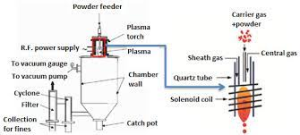
(source from Internet)
Advantages:Â The powder has a regular shape, high spheroidization rate, smooth surface and good fluidity. Can prepare high melting temperature refractory metals such as tantalum, tungsten, niobium and molybdenum. Disadvantages: long heating cycle, easy to evaporate volatile elements, large surface area of irregular powder, high oxygen content. Method comparison
The particle size range of the powder prepared by the PREP method is narrow; it is difficult to obtain fine powder, and the fine powder yield could be higher. Due to the high cost of fine powder, its application in the SLM process is greatly restricted. The coarse powder prepared by this technology is applied in the laser rapid prototyping LSF process.
The PA method has been used to prepare conventional titanium and titanium alloy powders. The powder contains satellite powder, flake powder, nanoparticles, etc. After processing, the powder has good fluidity. Since the wire is required as raw material, this technology encounters bottlenecks in the preparation of difficult-to-deform metal materials, and the material has a narrow application range. The production costs are relatively high in the production of inactive metal powders such as nickel-based and iron-based alloys.
Due to its advantages such as high efficiency, wide alloy adaptability, low cost, and controllable powder particle size, the VIGA method is a technical method commonly used by additive manufacturing powder suppliers worldwide. Compared with the PREP method in the preparation of active metal powder, the EIGA method has the advantages of saving materials, flexible production, and more fine powder output. It is suitable for producing and preparing titanium alloy powder for SLM processes.
Supplier
TRUNNANO is a supplier of Ti6AI4V alloy and other metal materials with over 12 years experience in nano-building energy conservation and nanotechnology development. It accepts payment via Credit Card, T/T, West Union and Paypal. Trunnano will ship the goods to customers overseas through FedEx, DHL, by air, or by sea. If you are looking for high-quality Ti6AI4V alloy and other metal materials please feel free to contact us and send an inquiry.